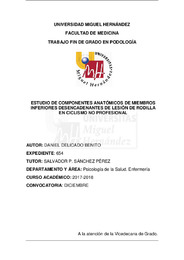Por favor, use este identificador para citar o enlazar este ítem:
https://hdl.handle.net/11000/25864Registro completo de metadatos
| Campo DC | Valor | Lengua/Idioma |
|---|---|---|
| dc.contributor.advisor | Sánchez Pérez, Salvador Pedro | - |
| dc.contributor.author | Delicado Benito, Daniel | - |
| dc.contributor.other | Departamentos de la UMH::Psicología de la Salud | es_ES |
| dc.date.accessioned | 2022-02-11T09:00:12Z | - |
| dc.date.available | 2022-02-11T09:00:12Z | - |
| dc.date.created | 2017-12-04 | - |
| dc.identifier.uri | http://hdl.handle.net/11000/25864 | - |
| dc.description.abstract | Introducción: Se ha demostrado que un mal ajuste biomecánico o la inexistencia de este, disminuye el rendimiento del ciclista, puede provocar lesiones y además puede empeorar la evolución de patologías previas. Realizamos breve introducción a la anatomía de la rodilla ya que es la articulación más comprometida durante la práctica del ciclismo y por tanto la más propensa a sufrir lesiones. Objetivos: Establecer las pruebas relevantes necesarias complementarias para la exploración del miembro inferior en caso de lesión de la rodilla. Material y métodos: Se realizó una exploración biomecánica a 51 pacientes del Centro de Biomecánica Ciclista TechCyclist de Elche que presentaban molestias en las rodillas. Además se les suministró un cuestionario con varias preguntas con cuestiones sociodemográficas y referentes su actividad como ciclistas. Resultados y conclusiones: Tras la revisión de los test biomecánicos y de exploración podemos afirmar que los sujetos que acuden por problemas de rodilla padecen algún tipo de disfunción muscular o articular de otros segmentos de su cadena cinética, pero no podemos comprobar nuestra hipótesis de que la lesión de la rodilla del ciclista está condicionada por la alteración del gesto deportivo y está desencadenada por la acción de la musculatura y articulaciones de su cadena cinética. Precisamos segmentar los datos y establecer cruces de variables así como establecer la estadística conociendo si el miembro lesionado es dominante o no. | es_ES |
| dc.description.abstract | Introduction: It has been demonstrated that a bad biomechanical adjustment or the nonexistence of this one, diminishes the performance of the cyclist, can cause injuries and in addition, it can worsen the evolution of previous pathologies. There is also a brief introduction to the anatomy of the knee since it is the most involved joint during the practice of cycling and therefore the most prone to injury. Goals: To establish the necessary complementary tests necessary for the exploration of the lower limb in case of knee injury. Material and methods: A biomechanical exploration was performed on 51 patients of the Cyclist Biomechanics Center TechCyclist of Elche who presented with discomfort in the knees. They were also given a questionnaire with several questions with personal questions and referring to their activity as cyclists. Results and conclusion: After reviewing the biomechanical and examination tests we can say that the subjects who come for knee problems suffer from some type of muscular or joint dysfunction of other segments of its kinetic chain, but we can not verify our hypothesis that the knee injury of the cyclist is conditioned by the alteration of the sporting gesture and is triggered by the action of the muscles and joints of its kinetic chain. We need to segment the data and establish crossings of variables as well as establish the statistics knowing if the injured member is dominant or not. | es_ES |
| dc.format | application/pdf | es_ES |
| dc.format.extent | 25 | es_ES |
| dc.language.iso | spa | es_ES |
| dc.publisher | Universidad Miguel Hernández | es_ES |
| dc.rights | info:eu-repo/semantics/openAccess | es_ES |
| dc.rights | Attribution-NonCommercial-NoDerivatives 4.0 Internacional | * |
| dc.rights.uri | http://creativecommons.org/licenses/by-nc-nd/4.0/ | * |
| dc.subject | ciclismo | es_ES |
| dc.subject | lesiones | es_ES |
| dc.subject | articulación | es_ES |
| dc.subject | biomecánica de la rodilla | es_ES |
| dc.subject | cadena cinética | es_ES |
| dc.subject.other | CDU::6 - Ciencias aplicadas | es_ES |
| dc.title | Estudio de componentes anatómicos de miembros inferiores desencadenantes de lesión de rodilla en ciclismo profesional | es_ES |
| dc.type | info:eu-repo/semantics/bachelorThesis | es_ES |

Ver/Abrir:
654_DELICADO_BENITO_DANIEL.pdf
624,77 kB
Adobe PDF
Compartir:
 La licencia se describe como: Atribución-NonComercial-NoDerivada 4.0 Internacional.
La licencia se describe como: Atribución-NonComercial-NoDerivada 4.0 Internacional.
.png)